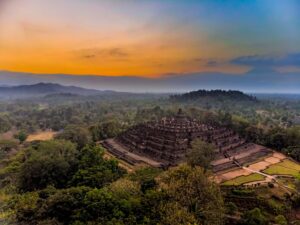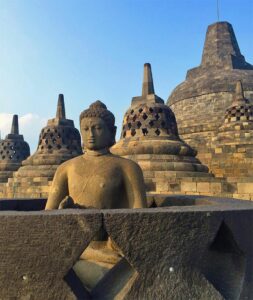Indonesia is a country rich in cultural heritage and long history. One place that reflects Indonesia’s rich culture and history is the Yogyakarta Palace. This palace is one of the oldest and most important palaces in Indonesia, and has a very long history, starting from the Giyanti Agreement in 1755 until the independence era of the Republic of Indonesia in 1945. This article will discuss the history of Kraton Yogyakarta for almost two centuries.
Giyanti Treaty and the Formation History of Kraton Yogyakarta

The history of the Yogyakarta Palace began in 1755 when the Giyanti Agreement occurred between the Dutch and Mataram. This agreement was made to end the Mataram Succession War which has been raging in recent years. The result of this agreement was the division of the Mataram Sultanate into two parts, namely the Surakarta Sultanate led by Sunan Pakubuwono III and the Yogyakarta Sultanate led by Sultan Hamengkubuwono I.
Sultan Hamengkubuwono I was the central figure in the formation of the Yogyakarta Sultanate. He is the grandson of Sultan Agung Hanyakrakusuma, who is one of the great figures in Mataram history. Initially, the Yogyakarta Sultanate was centered in Kartasura City, but was later moved to Yogyakarta in 1756. Construction of the Yogyakarta Palace, which became the center of the Sultanate’s government, began in the same year.
Era of Development and Culture of the Yogyakarta Palace

Sultan Hamengkubuwono I was an influential ruler and was able to build the foundations of the Yogyakarta Sultanate. One of the most famous is the construction of the Yogyakarta Palace, which became a symbol of the Sultanate’s power and culture. During his reign, many other important buildings and places were built, including Taman Sari, a complex of fountains and gardens that became a recreation area for the royal family.
Apart from physical infrastructure, Sultan Hamengkubuwono I also provided great support for arts and culture. Literature and performing arts flourished under his patronage. Shadow puppetry, one of Java’s most famous traditional art forms, received special attention during his reign.
The Era of Dutch Colonialism and Resistance

The Yogyakarta Sultanate was inseparable from Dutch interference during their era of colonialism. During the early 19th century, the Dutch tried to expand their influence in Central Java. Sultan Hamengkubuwono II who ruled at that time, together with the people of Yogyakarta, resisted these Dutch efforts. The most famous war was the Diponegoro War which took place between 1825 and 1830. Raden Mas Diponegoro, a Javanese prince, led fierce resistance against the Dutch, and this war had a major impact on the Sultanate of Yogyakarta.
As a result, after the Diponegoro War ended, the Yogyakarta Sultanate had to hand over some of its territory to the Dutch. At that time, Sultan Hamengkubuwono III, who ruled, tried to maintain the stability of the Sultanate in a difficult situation. The Dutch, meanwhile, continued to expand their power in Indonesia.
The Era of Modernization Under Sultan Hamengkubuwono IX

Sultan Hamengkubuwono IX, who ruled from 1940 to 1988, is one of the most important figures in the modern history of the Yogyakarta Palace. During his reign, the Sultanate underwent a major transformation. Sultan Hamengkubuwono IX was very involved in social, economic and political development in Yogyakarta.
One of his important actions was in 1950, when Indonesia proclaimed its independence. Sultan Hamengkubuwono IX decided to unite the Sultanate of Yogyakarta with the Republic of Indonesia, so that Yogyakarta became part of the Republic of Indonesia. At the same time, he introduced various reforms within the sultanate, including legal and administrative reforms.
Yogyakarta Palace in the Era of Independence
Since Yogyakarta became part of the Republic of Indonesia, the political role of the Sultanate has been reduced significantly. However, the Yogyakarta Palace remains a very important symbol of culture and tradition for the people of Yogyakarta and Indonesia in general. Sultan Hamengkubuwono He is also involved in various cultural and social activities that have a positive impact on the people of Yogyakarta.
Yogyakarta Palace is one of the most iconic and historic places in Indonesia. With its long history, from the Giyanti Agreement to the modern era, the Yogyakarta Palace reflects the struggle and development of Indonesia as a nation. In its long history, the Yogyakarta Palace has also experienced various changes and challenges, but has remained the guardian of its rich cultural and historical heritage.
The Relationship between the Solo Palace and the Yogyakarta Palace: Harmony in the Middle of a Long History
Indonesia’s history is rich in cultural heritage and kingdoms that have existed for centuries. Among these kingdoms, the Solo Palace (Surakarta) and the Yogyakarta Palace are the two most famous. They have a long and deep history, reflecting Indonesia’s cultural and historical diversity. Currently, even though Indonesia has become a modern country with a central government, the Solo Palace and Yogyakarta Palace still have an important role in the culture and traditions of Javanese society. This article will review the current relationship between the two palaces.
The Long History of the Solo Palace and the Yogyakarta Palace
Solo Palace and Yogyakarta Palace, although located in different cities, have the same historical roots. They started from the Mataram Sultanate which was centered in Kartasura City. In the 18th century, the Mataram Sultanate experienced internal conflict and civil war. The Giyanti Agreement in 1755 then ended this conflict and divided Mataram into two parts, namely the Surakarta Sultanate led by Sunan Pakubuwono III and the Yogyakarta Sultanate led by Sultan Hamengkubuwono I.
Since then, these two palaces have become separate centers of government and culture. Each palace has a king or sultan who rules independently, as well as a unique system of government and cultural traditions. These two palaces maintained their sovereignty during the Dutch colonial period and continued to play an important role after Indonesia became independent in 1945.
Current Relations between the Two Palaces
Even though they are administratively separate, the Solo Palace and the Yogyakarta Palace are closely related in many aspects of life. One of the most famous aspects is the kinship relationship between the kings of these two palaces. They have a long family relationship and recognize each other as brothers.
Apart from that, these two palaces also often interact in cultural activities and official ceremonies. They participate in various traditional ceremonies, both religious and secular. These two palaces also have famous choirs and dance groups in Indonesia, which often perform together in cultural arts performances.
In social and cultural aspects, the people of Solo and Yogyakarta have many similarities. They share the same language, traditions, and cultural values. Both have a variety of traditional arts, such as shadow puppetry and traditional Javanese dance, which continue to be preserved and developed.
The Role of the Palace in Community Life
Even though these two palaces no longer have a significant political role, they are still very relevant in the lives of Javanese society. The people of Solo and Yogyakarta still respect and appreciate the palace as the guardian of their traditions and culture. Traditional ceremonies, weddings and many aspects of community life are still influenced by palace traditions.
Apart from that, these two palaces also have a role in education and community development. They are involved in various social and cultural activities aimed at advancing society, especially in the fields of arts and culture. The Solo Palace and Yogyakarta Palace also play a role in preserving Indonesia’s cultural heritage.
The relationship between the Solo Palace and the Yogyakarta Palace reflects the rich culture and history of Indonesia. Even though they are administratively separate, these two palaces still have close relations in various aspects of life. They play an important role in preserving and developing Javanese culture, as well as being a symbol of Indonesia’s rich cultural heritage. The harmony between the two creates a strong force in maintaining and respecting Indonesian traditions and culture which are rooted in long history.





